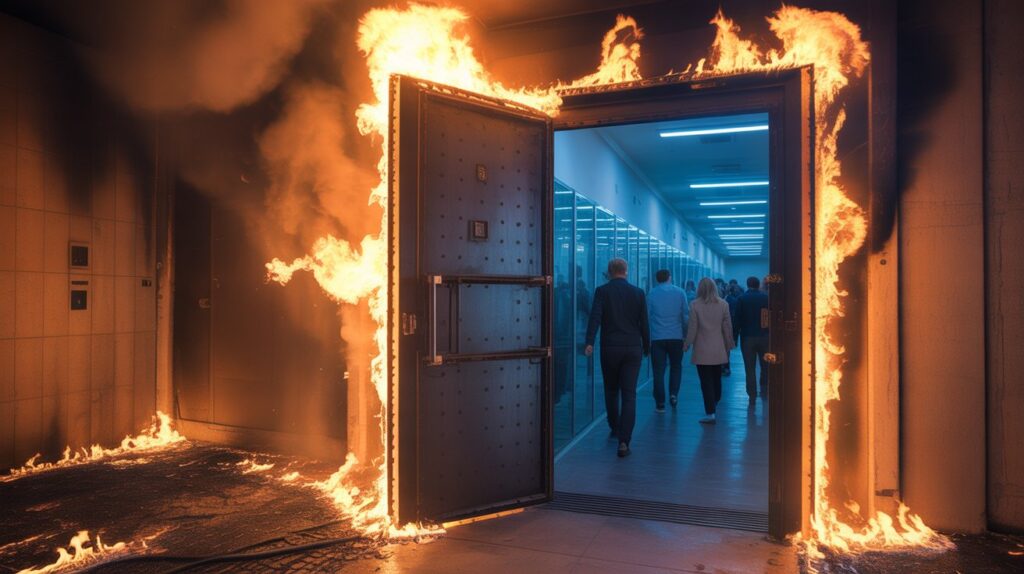Fire—one of nature’s most destructive forces—can spread through a building faster than most people realize. In just two to three minutes, a small spark can turn into a raging blaze, consuming everything in its path. Yet amid that chaos, one simple, engineered barrier stands between safety and catastrophe: the fire door.
Fire doors are more than metal sheets with locks and hinges. They are meticulously designed shields that contain fire and smoke, giving people time to escape and firefighters a chance to gain control. Understanding how fire doors work, the science behind their construction, and their role in modern fire safety standards can make the difference between life and loss.
The Hidden Guardian in Every Building
Walk through an office, apartment complex, hospital, or school, and you’ll pass fire doors countless times without noticing. Most of us don’t stop to think about how vital these doors are until an emergency strikes.
A properly fitted fire door performs two key life-saving tasks:
- It compartmentalizes the building, preventing flames from spreading to other areas.
- It resists the infiltration of deadly smoke and toxic gases.
By creating these safety zones, fire doors turn entire buildings into strategic networks of containment. In essence, they buy time—the most precious commodity during a fire.
Fire Containment: The Core Principle
The science of fire protection revolves around a single concept: containment. Whether it’s through firewalls, suspended ceilings, fire-resistant cables, or coatings, the goal is to resist the spread of heat and combustion products long enough for evacuation and response.
Fire doors are a central part of this containment strategy. They act as barriers within the compartmentation system—dividing large structures into smaller, more manageable sections that can isolate fire. This system effectively slows down flame propagation and allows safe egress routes to stay viable longer.
To understand how this works, we must look at the composition and technology that make fire doors so effective.
The Science Inside: Layers of Defense
A fire door’s capability lies in its materials and testing. It’s not about thickness alone—it’s about what’s inside.
Core Materials
The core of a fire door determines how well it can withstand intense heat. Common core materials include:
- Solid timber: Used in traditional designs but enhanced with fire-resistant layers.
- Mineral composites: Non-combustible cores that offer superior heat resistance.
- Gypsum and engineered boards: They expand and harden when heated, maintaining the door’s integrity.
Intumescent Seals
Along the edges of every fire door is a small but powerful component—the intumescent strip. This heat-reactive material expands up to 20 times its original size when exposed to fire, sealing the gap between the door and its frame.
This transformation locks out smoke, flames, and hot gases, making it one of the most crucial features for life protection. Without intumescent seals, even a few millimeters of clearance could become a deadly leak.
Fire-Resistant Glazing
Modern architectural design often calls for visibility and natural light, even in safety-critical areas. Fire-resistant glass solves this conflict. These special glazings are made from reinforced multi-layer materials that can withstand exposure to over 900°C for extended periods without shattering. They allow safe visibility, aiding in rescue operations and occupant movement.
Smoke Seals
While the fire-resistant core holds flames, smoke seals tackle the invisible killer—smoke. Inhalation of toxic gases accounts for over 70% of fire fatalities worldwide. These seals form air-tight barriers to block smoke migration through corridors and stairwells, keeping escape routes breathable.
The Engineering Behind Fire Door Ratings
Not all fire doors are created equal. Their effectiveness is determined by how long they can resist fire during a controlled test, usually expressed as FD30, FD60, FD90, or FD120, meaning 30, 60, 90, or 120 minutes of protection.
The testing process involves:
- Furnace exposure: The door is installed in a wall and exposed to a standardized fire curve simulating real temperatures.
- Integrity and insulation checks: Engineers monitor whether flames or hot gases breach the door or cause excessive heat transfer.
- Deformation and latch strength: The door must remain closed and functional despite extreme stresses.
This rigorous testing ensures each certified door can hold back fire long enough for evacuation, alarm activation, and firefighting response.
Fire Doors in Action: Life-Saving Scenarios
In real-world fires, properly installed fire doors have been responsible for countless lives saved. For example:
- Grenfell Tower (2017): Despite the tragedy, several apartments with closed fire doors delayed smoke and flame entry, allowing occupants to escape.
- Hospital fire cases often show that fire compartmentation—enabled by fire doors—can keep critical care units safe while firefighters extinguish the source.
- In educational institutions, where children’s evacuation must be swift and orderly, fire doors turn sprawling corridors into controlled safety sections.
Each scenario confirms a vital truth: when working properly, fire doors are not just passive materials—they are active safety defenses.
Common Mistakes That Undermine Fire Door Safety
However, the protection a fire door offers is only as good as its installation and maintenance. Unfortunately, small errors can completely destroy their effectiveness.
1. Wedging Doors Open
Perhaps the most widespread issue, propping open fire doors negates their very purpose. Even if left open for airflow or convenience, in a fire scenario the door will fail to contain smoke and flames.
2. Poor Installation
Misaligned frames, oversized gaps, and incorrect hardware prevent the door from sealing effectively. Only licensed professionals following manufacturer instructions should install or maintain fire doors.
3. Damaged or Missing Seals
If intumescent or smoke seals are cracked, paint-covered, or missing, the barrier becomes compromised. Regular inspections are critical to catch these issues early.
4. Inappropriate Modifications
Cutting holes for vision panels, letterboxes, or air grilles without proper certification voids the door’s fire rating. Every modification must be tested and approved.
Regular maintenance and annual inspections help ensure fire doors continue to perform at their rated standards throughout their lifespan.
The Role of Standards and Regulations
Fire door compliance is regulated by building codes and safety standards across most countries. These requirements ensure that every door installed in a public or high-occupancy space is capable of withstanding fire exposure and protecting escape routes.
Some key global standards include:
- BS 476 / EN 1634 (Europe): Covers testing for fire resistance and smoke control.
- NFPA 80 (USA): Details installation, maintenance, and testing procedures.
- IS 3614 / NBC 2016 (India): Defines specifications for fire-rated door construction and testing.
In India, for example, the National Building Code mandates fire doors in stairwells, corridors, lift lobbies, and exits, particularly in high-rise and industrial buildings. Compliance isn’t optional—it’s a legal obligation tied to occupancy certification and safety audits.
Fire Door Hardware: Small Details, Big Impact
Every hinge, latch, closer, and seal in a fire door system is part of the containment design. Self-closing devices, for instance, ensure that doors automatically return to a closed position after use, eliminating human error.
Fire-rated hinges must resist warping or failure under heat. Locks and handles must also maintain structural integrity without transmitting heat that could ignite materials on the safe side. Even the screws matter—wrong choices can weaken performance.
Each hardware component must carry its own fire rating to match the door’s classification and manufacturer certification.
Technological Advances in Fire Door Innovation
As materials science evolves, so do fire doors. Modern designs now integrate aesthetic, environmental, and digital features without compromising safety.
Smart Fire Doors
These incorporate sensors, IoT connectivity, and automated closing systems. When linked to a building’s fire alarm, they can close instantly once smoke or heat is detected, even if occupants forget.
Sustainable Fire-Resistant Materials
Eco-friendly composites using recycled mineral fibers and low-VOC coatings are emerging, meeting green building certifications such as LEED and GRIHA.
Enhanced Intumescent Technologies
Next-generation seals can respond to fire within seconds of exposure, providing earlier containment and higher reliability under extreme environments.
Together, these innovations expand the possibilities for safer yet visually appealing architecture.
Fire Doors and Passive Fire Protection Systems
Fire doors form part of the passive fire protection (PFP) strategy—those built-in building elements designed to contain fires without active intervention. While active systems such as sprinklers and alarms detect and suppress fires, passive systems focus on limiting their spread.
The interplay between the two is essential:
- Passive systems confine the fire to a limited zone.
- Active systems extinguish or control the blaze within that zone.
This synergy enhances life safety, reduces damage costs, and simplifies emergency operations. Without robust passive elements like fire doors, no active system can perform effectively.
Why Maintenance Is a Matter of Life and Law
Fire doors, much like alarms and sprinklers, require periodic checks. Dust, wear, or even minor misalignment can compromise performance during an emergency.
Inspection parameters often include:
- Door alignment and ease of closure
- Condition of seals and hinges
- Proper latch engagement
- Visible certification labels and compliance documentation
Globally, certification bodies recommend inspections every six months, or more frequently in high-traffic areas like hospitals or schools. Maintenance isn’t just good practice—it’s often legally enforceable.
Human Behavior and Awareness
Despite technological advancements, human behavior remains a determining factor. Training employees, residents, or students to respect and recognize the purpose of fire doors is vital.
Awareness campaigns should emphasize:
- Never propping open or tampering with fire doors
- Reporting damage immediately
- Understanding that closed fire doors mean safety—not inconvenience
Even the most sophisticated door is ineffective if misused. Education bridges that gap.
Designing Buildings Around Safety
Architecture today balances beauty with resilience. Fire doors, though utilitarian, are integral to design planning. Architects and engineers must consider:
- Escape route configuration
- Occupancy loads and travel distances
- Compartmentation zones for fire and smoke
- Aesthetic integration without loss of performance
With the advent of slimline steel doors, concealed closers, and high-end finishes, fire-rated doors no longer clash with modern interiors—they complement them.
The Real Value: Time
When a fire breaks out, every second counts. The most advanced alarm or sprinkler system can fail if occupants can’t reach safety in time. Fire doors convert unpredictable chaos into manageable structure by keeping danger localized.
The time they buy—30, 60, or 120 minutes—can mean the difference between total loss and a controlled rescue. In those precious moments, people evacuate, fire crews arrive, and damage stays containable.
That’s why some experts call fire doors “the quiet heroes of fire safety.”
The Future of Fire Safety Engineering
The coming decade will see greater integration of AI-driven fire monitoring, intelligent building materials, and predictive safety systems. Fire doors will likely include real-time health monitoring sensors that report wear, seal integrity, and closure status to facility managers automatically.
Fire safety will no longer depend solely on periodic human inspection; it will become a continuously monitored ecosystem—reducing risk, optimizing response, and extending structural life cycles.
Final Thoughts: Respect the Door That Saves Lives
Fire doors embody the principle of prevention through design. They are deceptively simple yet scientifically profound—combining thermodynamics, materials engineering, human factors, and law into a single safety solution.
Every closed fire door represents both time and hope—the two things that keep people alive in the face of disaster.
So next time you pass through one and hear it close behind you, remember: it’s not just a door. It’s a silent, vigilant guard, standing ready to save lives through the science of containment.


Pingback: Fire Doors in Indian: Essential Safety Solutions - Altic Paint